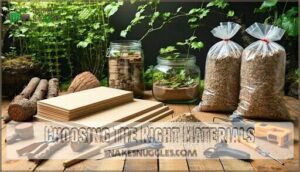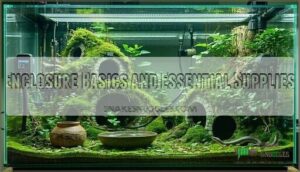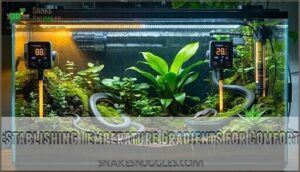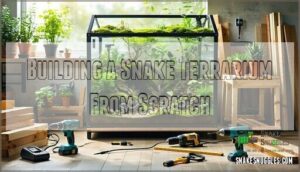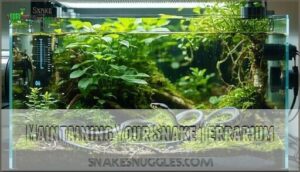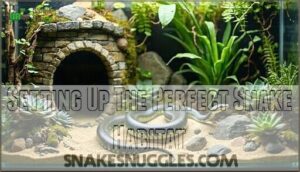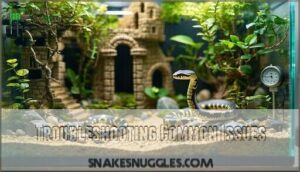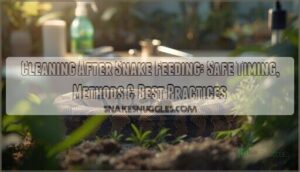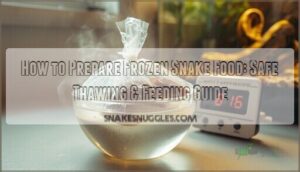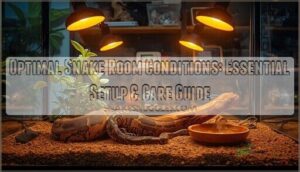This site is supported by our readers. We may earn a commission, at no cost to you, if you purchase through links.
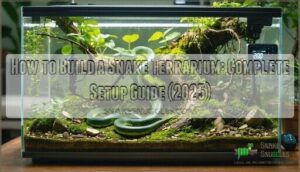 Building a snake terrarium from scratch gives you complete control over size, materials, and layout to match your species’ exact needs. Start by choosing durable, non-toxic materials like PVC or untreated wood for the frame, paired with glass or thermoplastic panels for visibility and easy cleaning.
Building a snake terrarium from scratch gives you complete control over size, materials, and layout to match your species’ exact needs. Start by choosing durable, non-toxic materials like PVC or untreated wood for the frame, paired with glass or thermoplastic panels for visibility and easy cleaning.
Set up your heat sources with thermostats to create the right temperature zones—snakes need both warm and cool spots to regulate their body temp. Add ventilation to keep moisture in check, and place hiding spots at each end so your snake feels secure wherever they are.
Pick substrate that matches where your snake comes from in the wild. If you’ve got a climber, throw in some branches or ledges. And double-check those door latches—snakes are escape artists.
It takes some work up front, but building your own usually runs cheaper than buying pre-made while giving you an enclosure that fits your snake exactly—and adapts as they grow.
Table Of Contents
- Key Takeaways
- Planning Your Snake Terrarium
- Choosing The Right Materials
- Selecting Sturdy Wood for The Frame
- Deciding Between Glass and Thermoplastic Panels
- Analyzing Cost Differences and Durability
- Essential Tools for Construction
- Enclosure Basics and Essential Supplies
- Stylish and Space-Saving Options
- Cabinet-Style Enclosures for Ample Space
- Custom and Scalable Options for Flexibility
- Designing a Snake-Friendly Environment
- Building a Snake Terrarium From Scratch
- Maintaining Your Snake Terrarium
- Upgrading and Renovating Your Snake Enclosure
- Creating a Safe and Secure Enclosure
- Setting Up The Perfect Snake Habitat
- Troubleshooting Common Issues
- Frequently Asked Questions (FAQs)
- What is the best material for a snake terrarium?
- What do you need to build a snake enclosure?
- How do you make a good snake habitat?
- What is the minimum cage size for a snake?
- What size tank does my snake need?
- How often should I clean the terrarium?
- Can I use a heat lamp for heating?
- How do I prevent my snake from escaping?
- What types of substrate are best for snakes?
- What substrate works best for burrowing snake species?
- Conclusion
Key Takeaways
- Building your own snake terrarium saves roughly 40% compared to commercial options while giving you complete control over dimensions, materials, and species-specific features like temperature gradients and climbing structures. – Proper enclosure design requires durable, non-toxic materials (PVC, untreated hardwood, or HDPE for frames; glass or thermoplastic for panels) combined with escape-proof latches, strategic ventilation, and hiding spots in both warm and cool zones. – Creating a healthy habitat means establishing a temperature gradient of 75-80°F on the cool end and 85-95°F for basking, maintaining species-appropriate humidity levels (40-80% depending on your snake), and providing substrate that matches your snake’s natural burrowing or climbing behaviors. – Regular maintenance includes daily spot-cleaning and water changes, weekly substrate replacement, monthly disinfection with reptile-safe cleaners, and consistent monitoring of temperature and humidity with digital thermometers and hygrometers to catch problems before they affect your snake’s health.
Planning Your Snake Terrarium
Building a terrarium that keeps your snake healthy starts with understanding what your species needs. Before you pick up tools or materials, you’ll want to nail down four essentials: the right dimensions, quality construction materials, proper heating zones, and secure places where your snake can hide or bask.
Determining The Right Size and Layout
Before you cut a single board or measure out glass panels, you’ll need to nail down the most critical decision: how much room your snake actually needs to thrive.
Your enclosure size should match at least twice your snake’s adult length—so a four-foot corn snake needs an eight-foot tank. Don’t forget vertical space for climbers like green tree pythons, and plan your enclosure layout now to accommodate future growth and habitat complexity.
Choosing The Right Materials and Equipment
Now that you’ve figured out your enclosure dimensions, it’s time to pick the building blocks that’ll keep your snake safe and make your life easier.
You’ll want materials that hold up and actually work. Here’s what matters:
- Frame materials: Untreated wood or PVC works great—avoid chemical-treated lumber that could poison your snake
- Panels: Glass offers visibility and easy cleaning, while thermoplastic panels weigh less and won’t shatter
- Ventilation systems: Mesh panels or drilled holes prevent moisture buildup without compromising security
- Security features: Heavy-duty hinges and hook-and-eye latches stop escape artists cold
Solid materials pay off long-term—you’ll get years out of a well-built enclosure instead of rebuilding every season.
Heating, lighting, and substrate choices matter just as much, and that’s where we’re headed.
Creating a Temperature Gradient
Your snake’s not asking for much—just a warm spot to digest and a cool corner to chill—so let’s set up that temperature range the right way.
Position your heat source on one end to create a basking area around 85–95°F, while the opposite side stays cooler at 75–80°F. Install a thermostat to maintain consistent temps and prevent overheating.
Use digital thermometers at both ends for gradient monitoring—different species needs vary, so check requirements for your particular snake. This thermal gradient lets your pet thermoregulate naturally, moving between zones as needed for prime health.
Providing Hiding Spots and Basking Areas
Once you’ve got that temperature sorted, think about what happens next—snakes spend most of their time hidden away or lounging under a heat source, so placement matters more than you’d think.
You’ll want to cover a few key areas when setting things up. Put secure hides on both the warm and cool sides so your snake can retreat safely anywhere. Install basking platforms under your heat source for easy thermoregulation. Throw in some branches and climbing structures for enrichment and natural behavior. And create some shade between hiding spots and the basking area using plants or cork bark.
Choosing The Right Materials
Building a quality terrarium starts with selecting the right materials—your choices here affect both durability and your snake’s safety.
Let’s look at the key materials you’ll need and how to choose between your options.
Selecting Sturdy Wood for The Frame
Your material choices matter more than you might think—they determine how long your terrarium lasts and whether your snake stays safe.
Here’s what you need and how to pick between options.
Hardwoods like oak, maple, or birch offer greater frame durability and moisture resistance—critical when you’re dealing with humidity levels that’d make a rainforest jealous. Skip pine or cedar entirely; wood toxicity from their aromatic oils causes respiratory distress in snakes.
Yes, hardwoods cost more upfront, but sustainable sourcing options exist, and sturdy wood means you won’t be rebuilding next year. Think of it as woodworking insurance.
Deciding Between Glass and Thermoplastic Panels
When you’re standing in the hardware store staring at panels, wondering which material won’t leave you second-guessing your choice six months down the road—that’s exactly where most first-time builders find themselves. Here’s what actually matters:
- Glass panels offer enhanced material transparency and visual clarity, letting you observe your snake without distortion.
- Thermoplastic panels win on impact resistance—they won’t shatter if accidentally knocked.
- Weight comparison favors thermoplastic; it’s considerably lighter for easier handling during construction.
- Insulation properties differ considerably—plastic panel materials retain heat better than glass, potentially reducing heating costs.
Glass thickness generally starts at 3-4mm for smaller enclosures, while plastic panels come in various gauges.
Analyzing Cost Differences and Durability
Budget-conscious builders often gravitate toward sturdy wood and thermoplastic panels, but enclosure material costs tell only part of the story. Commercial PVC units run $250–$400, while DIY builds using hardwoods or high-density polyethylene (HDPE) average $250–$500 depending on regional price trends.
For a basic 4x2x2 enclosure, the total DIY cost can be around $300. Here’s the durability trade-off: HDPE enclosures last 20+ years with minimal long-term expenses, whereas budget glass tanks may need replacement after impacts.
Building materials matter—cost-effective doesn’t mean cheap when you’re balancing DIY vs. commercial options for a snake’s lifetime home.
Essential Tools for Construction
You’ll need more than enthusiasm to turn raw materials into a proper enclosure—a solid toolkit separates successful DIY builds from frustrating half-finished projects.
Start with cutting tools like a circular saw for panels and a jigsaw for ventilation holes. Your drill takes care of screws and pilot holes, while measuring tape ensures accurate dimensions.
Don’t skip safety gear—goggles and gloves protect you during construction. A router creates smooth edges, and wood glue reinforces joints for lasting durability.
Getting the right tools matters more than you’d think—without them, you’re setting yourself up for a frustrating mess instead of a finished enclosure.
Building your own snake enclosure gives you complete control over size, materials, and design. Let’s explore four practical approaches that work for different spaces, budgets, and skill levels.
Enclosure Basics and Essential Supplies
When you build your own snake enclosure, you pick exactly what size works for your space, what materials fit your budget, and how the whole thing looks.
Here are four ways to do it, depending on what kind of setup you’re working with.
You’ll need substrate types like coconut fiber or aspen for easy cleanup, heating options such as under-tank heaters, and lighting needs to maintain temperature and humidity levels.
Don’t skip hiding essentials and water bowls; your snake terrarium won’t feel like home without them.
Stylish and Space-Saving Options
If you’re short on square footage but long on reptile love, you don’t have to choose between your snake and your living room. Vertical terrariums and corner enclosures expand floor space, while repurposed furniture transforms old cabinets into stylish custom snake enclosures. Stackable designs let you expand your collection without sacrificing your apartment’s breathing room.
Here’s how to blend function with form:
- Built-in enclosure units disguise your DIY snake enclosure as sleek shelving
- Furniture-style terrarium designs double as end tables or console pieces
- Minimalist aesthetics with clean lines keep your setup uncluttered
When space is tight, you need to get creative with placement and design:
Cabinet-Style Enclosures for Ample Space
Cabinet-style enclosures take space-saving one step further—think of them as entire snake apartments hidden in plain sight. These furniture-style terrarium designs blend seamlessly with your home decor while providing spacious snake homes for large snake breeds. Custom cabinet designs offer furniture integration that transforms a bedroom dresser or living room credenza into a thriving habitat with an enhanced viewing area.
Here’s what makes cabinet-style builds stand out:
- Ample Floor Space: Custom snake enclosures accommodate adult boas, pythons, or rat snakes that need room to stretch and explore.
- Built-In Storage: Lower drawers house heat lamps, thermostats, frozen feeders, and cleaning supplies—everything’s within arm’s reach.
- Disguised Ventilation: Decorative side panels conceal mesh inserts that maintain airflow without disrupting your aesthetic.
Custom and Scalable Options for Flexibility
What if you could design an enclosure that grows with your snake instead of scrambling to rebuild every few years? Modular designs and expandable enclosures solve this puzzle perfectly.
Building a snake terrarium with adaptable terrariums means you can add panels, swap heating zones, or adjust floor space as your snake matures. DIY kits with modular panels offer future-proofing without the hefty price tag—just reconfigure sections when your corn snake graduates from juvenile to adult.
Spacesaving designs keep things tidy while your adaptable setup evolves alongside your pet’s needs.
Designing a Snake-Friendly Environment
Your snake’s terrarium isn’t just a box—it’s a miniature ecosystem that promotes natural behaviors and keeps your pet healthy.
Let’s walk through the key elements you’ll need to create a space where your snake can hide, climb, thermoregulate, and thrive.
Creating Cozy Hides and Burrows
Think of your snake’s terrarium as its whole world. When you set it up right, your snake gets to act like it would in the wild—hiding when it needs to, climbing around, moving between warm and cool spots.
Here’s what you need to build that kind of space. We’ll cover the basics that let your snake hide, explore, regulate its body temperature, and stay healthy.
Use naturalistic materials like cork bark, hollow logs, or half-buried clay pots that promote secure hide design while retaining humidity. Cozy hides should fit snugly—just roomy enough for your snake to curl up inside.
If you’re using substrate material that allows burrowing, like coconut fiber, your snake can create its own burrows beneath the surface, mimicking how they’d behave in the wild.
Adding Climbing Structures for Natural Behavior
Snakes aren’t just floor dwellers—many species naturally climb, explore vertical spaces, and perch on elevated surfaces. Adding climbing structures like driftwood, grapewood, or securely anchored branches transforms your enclosure layout into a vibrant habitat that promotes behavioral diversity.
Research shows snakes with vertical climbing access move up to 40% more actively and display 33% fewer stereotypic behaviors. Choose branches at least 1.5 inches in diameter, fasten them with hardware rated for twice your snake’s weight, and span 50–75% of vertical space for arboreal species.
This environmental enrichment delivers real benefits: increased muscle mass, cognitive stimulation, and safer shedding. Structural safety matters—inspect climbing materials every 12 months and guarantee rough surfaces for secure grip. To further improve their well-being, consider sensory enrichment options like introducing novel scents.
Using Plants for Camouflage and Aesthetics
Live plants don’t just beautify your terrarium—they create lively hiding spots that shift with growth, reducing stress for snakes who instinctively seek cover in dappled foliage. Plant selection matters: pothos and spider plants offer lush visual appeal and humidity control, while artificial plants eliminate plant toxicity concerns. Safe plants like snake plants and bromeliads provide natural hiding and environmental enrichment without maintenance headaches.
Choose terrarium plants that deliver:
- Sturdy stems that won’t collapse under your snake’s weight
- Non-toxic foliage verified against reptile safety databases
- Dense leaf coverage for instinctive camouflage behavior
When picking out plants for your terrarium, look for options that check all the right boxes—sturdy, safe, leafy, and easy to care for.
Establishing Temperature Gradients for Comfort
When your snake shifts from one end of its home to the other, it’s hunting for the right temperature—not wandering aimlessly—so creating distinct warm and cool zones mimics the thermal choices wild snakes navigate daily.
Position your heat lamp or undertank heater (UTH) at one end for basking spot design, keeping the ambient temperature around 75°F at the cool end while your warm side reaches species-specific needs. Use thermostat calibration and consistent temperature monitoring to maintain this gradient—your snake’s health depends on it.
Essential gradient setup steps:
- Place heat sources strategically for proper heat source placement
- Monitor both ends with reliable thermometers for gradient measurement
- Adjust intensity based on your species’ thermal requirements
- Never skip thermostat calibration—consistency matters more than precision
Building a Snake Terrarium From Scratch
Building your own snake terrarium from scratch gives you complete control over every detail, from dimensions to ventilation.
Here’s how to tackle the construction process step by step, customize it for your snake’s specific needs, and avoid common pitfalls along the way.
Step-by-Step Guide to Construction
When you build a snake terrarium yourself, you get to choose exactly what works—size, airflow, materials, all of it.
Here’s how to put one together step by step, tweak it for your snake’s needs, and skip the mistakes most people make.
Install your heat source—whether an under-tank heater or ceramic bulb—and connect it to a reliable thermostat. Add substrate like aspen or coconut fiber, then drill ventilation setup holes along the sides.
Customizing The Enclosure for Your Snake’s Needs
Your snake’s enclosure isn’t just a box—it’s a custom environment that should match your specific species’ natural instincts and behavioral patterns. Building a Snake Terrarium means designing a comfortable environment with species-specific environmental preferences in mind.
Consider these customizations:
- Enclosure size: Provide at least twice your snake’s adult length for proper movement
- Substrate choice: Match bedding to humidity needs—aspen for dry species, coconut fiber for tropical ones
- Thermal gradients: Create warm and cool zones so your snake can self-regulate temperature
- Humidity control: Add water bowls or misting systems based on species requirements
- Enrichment items: Include branches, rocks, or cork bark for natural behaviors
Adjust your DIY snake enclosure to your pet’s biology, not generic advice.
Tips for a Successful Build
Building a successful snake terrarium isn’t rocket science, but a few smart moves will save you hours of frustration and keep your snake safe from day one. Measure twice, cut once—precision matters when choosing the right materials and equipment for enclosure construction.
Prioritize an escapeproof design with a secure lid and proper ventilation through mesh panels. Select safe substrate, install reliable temperature control systems, and monitor humidity levels closely.
Your DIY snake enclosure depends on attention to these fundamentals during the building process.
Maintaining Your Snake Terrarium
Building your snake terrarium is just the beginning—keeping it in top shape requires consistent attention and care.
Here’s what you need to focus on to make sure your snake thrives in its new home.
Cleaning The Enclosure Regularly
Setting up your snake’s terrarium is just step one—keeping it clean and healthy takes regular care.
To help your snake settle in and stay healthy, focus on a few key daily and weekly habits.
- Spot-clean daily: Remove feces and shed skin immediately to prevent bacterial growth
- Replace substrate weekly: Fresh bedding maintains hygiene and simplifies odor control
- Disinfect monthly: Use reptile-safe cleaners on all surfaces and decorations
- Clean water bowl daily: Scrub thoroughly to eliminate slime and bacteria
- Monitor for mold: Check humid hides and corners regularly for fungal growth
Monitoring Temperature and Humidity Levels
Once daily cleaning becomes routine, accurate monitoring of temperature and humidity levels protects your snake’s long-term health. Digital probe thermometers outperform stick-on types for measuring hot and cold zones, while digital hygrometers track humidity more reliably than analog dials. Place at least two thermometers in different zones to confirm proper gradient maintenance—basking sites should reach species-specific targets (85–100°F for most), and cool zones stay within 70–85°F. Check readings daily and recalibrate devices every 12 months to catch sensor drift before problems develop.
| Monitoring Element | Recommended Tool |
|---|---|
| Basking Site Temperature | Infrared temperature gun |
| Ambient Zone Temperature | Digital probe thermometer |
| Humidity Tracking | Digital hygrometer with memory |
| Real-Time Alerts | Remote monitoring system (Tempcube) |
Seasonal adjustments matter—winter heating bills climb, summer humidity spikes. Thermostats connected to heat sources prevent dangerous overheating beyond 110°F, while hygrometer calibration ensures you’re not misreading humidity by 10% or more. For ball pythons, maintain 60–80% humidity; corn snakes thrive at 40–60%. Proper thermometer placement directly on surfaces, not just measuring air, gives you the accurate data your snake depends on.
Observing Your Snake’s Behavior and Health
Thermometers and hygrometers give you the numbers, but your snake’s daily behavior tells the real story about whether your setup is working. Watch for signs of health like alert eyes, smooth shedding cycles, and consistent feeding responses. Behavioral changes often signal problems before equipment does:
- Appetite issues—refusing multiple meals suggests stress or illness
- Respiratory signs—wheezing or open-mouth breathing needs immediate vet attention
- Skin abnormalities—retained shed or discoloration points to humidity problems
Regular observation catches these red flags early, maintaining snake health through simple daily check-ins.
Practicing Quarantine Procedures
Bringing home a new snake without quarantine is like inviting a mystery guest to crash with your entire collection—you won’t know what problems they’re carrying until it’s too late.
Set up a separate isolation setup for at least 60 days, using dedicated equipment to prevent cross-contamination. During this monitoring period, watch for signs of stress like defensive behavior and signs of health including consistent feeding.
If anything seems off, contact a reptile vet before introducing your new snake to existing animals—disease prevention starts with patience.
Upgrading and Renovating Your Snake Enclosure
Your snake won’t stay small forever, and even if it does, you might want to improve its living space over time.
Here’s how to assess what changes are needed and make upgrades that benefit both you and your snake.
Assessing Your Snake’s Growing Needs
Your snake won’t always be tiny, and even if it stays small, you’ll probably want to spruce up its home down the road.
Let’s look at how you can spot what needs attention and upgrade your setup in ways that help both you and your snake.
- Tank size and enclosure dimensions: Your snake should stretch comfortably without constantly coiling against the walls—aim for at least twice its adult length.
- Dietary changes and growth rate: Moving from pinkies to larger prey signals rapid development and increased space requirements.
- Behavioral shifts in snake behavior: If your snake seems restless or frequently explores escape routes, it’s craving more room.
Regular veterinary checkups help you track species-specific needs and guarantee proper snake care as your serpent grows.
Making Changes to The Enclosure Layout
Once you’ve spotted those telltale signs of a cramped snake, it’s time to roll up your sleeves and rethink the layout. Start by moving hides to different zones—your snake’s behavior changes will guide what works.
Here’s a quick reference for habitat design tweaks:
| Layout Element | Optimization Strategy |
|---|---|
| Hides & Burrows | Reposition for temperature access |
| Climbing Structures | Add branches for enrichment activities |
| Substrate Depth | Increase for burrowing species |
| Basking Zones | Expand for size upgrades |
These safety adjustments create an adaptable setup that grows with your serpent, supporting natural snake behavior and enrichment for snakes.
Adding New Features and Accessories
Elevating your enclosure from functional to fascinating doesn’t require a complete overhaul—sometimes the smallest upgrades make the biggest difference in your snake’s daily experience. Consider habitat upgrades like custom backdrops mimicking natural environments, or add climbing structures with real branches for enrichment activities.
Automated systems for lighting can simulate day-night cycles, while aesthetic enhancements—artificial plants, textured water dishes, even furniture-style terrarium designs—create visual appeal.
Performance monitoring through these changes helps you track how upgrading and renovating your snake enclosure impacts behavior and comfort.
Creating a Safe and Secure Enclosure
A secure enclosure isn’t just about keeping your snake inside—it’s about creating a fortress that prevents escape while maintaining visibility and access for care.
Let’s walk through the key structural choices that make your terrarium both escape-proof and functional.
Choosing The Right Glass Panel Thickness
Keeping your snake safe isn’t only about making sure it can’t get out. You want a terrarium that’s practically escape-proof—but you also need to see inside easily and get in there when it’s time to clean or care for your pet.
Here’s what to look for in a terrarium that keeps your snake secure without making your life harder.
Tank size matters—bigger builds demand thicker glass for safety standards. While DIY vs professional options exist, choosing appropriate glass types based on your sizing considerations ensures your snake’s fortress stays secure without breaking your cost analysis budget.
Securing The Glass Panel With Adhesive
A bead of silicone can be the difference between a fortress and a revolving door for escape artists. Choose 100% aquarium-safe silicone sealant—it won’t leach toxins and bonds glass or plexiglass like a champion.
Here’s your game plan:
- Clean surfaces thoroughly with rubbing alcohol before applying adhesive
- Apply steady, continuous beads along frame edges for consistent coverage
- Smooth with a wet finger to eliminate air pockets and gaps
- Allow 24-48 hour curing time before adding substrate or your snake
- Test seal integrity by gently pressing the glass panel after curing
Proper application techniques guarantee long-term durability and safety precautions protect your snake from escape.
Using Sturdy Hinges and Latches
Hinges and latches aren’t just hardware—they’re your first line of defense against a Houdini in scales. Choose stainless steel hinges for corrosion resistance and long-term durability, especially in humid enclosures.
Install heavy-duty latches—like hook-and-eye or spring-loaded designs—at multiple points along the opening to prevent escape attempts. For households with kids, childproofing options add an extra security layer.
Proper installation techniques matter: pre-drill holes to avoid splitting wood, and test latch security by applying firm pressure before introducing your snake.
Preventing Escape Risks
Snakes possess surprising strength and problem-solving skills that can turn even the tiniest gap into an open door. To outsmart escape attempts, focus on these five essentials:
- Lid Security – Use heavy-duty latches at multiple points
- Gap Inspection – Check seams, corners, and ventilation areas weekly
- Latch Mechanisms – Install hook-and-eye or spring-loaded designs
- Secure Ventilation – Cover openings with fine mesh
- Cable Management – Seal all cord entry points tightly
Regular inspections of enclosure security will close potential escape routes before your snake finds them.
Setting Up The Perfect Snake Habitat
Once you’ve built a secure enclosure, the next step is creating the right living conditions inside. Let’s look at the key elements that’ll keep your snake comfortable and healthy.
Providing a Comfortable Temperature Gradient
With the enclosure ready, it’s time to focus on what goes inside. Here are the essentials your snake will need to feel right at home.
Your heating system needs thermostat calibration to prevent dangerous spikes. Use gradient monitoring tools—digital thermometers at both ends—to track species-specific needs and make certain your temperature gradient stays steady.
Creating a Natural Environment With Plants
Plants transform your terrarium from a heated box into a living ecosystem that works overtime for your snake’s health and your own enjoyment. Select safe plant species like pothos, snake plants, or ferns that tolerate humidity and won’t harm your reptile.
These terrarium setup additions regulate humidity, boost oxygen, and mimic a natural habitat—essential for creating a comfortable environment. Planting techniques matter: anchor roots in the substrate or use pots for easy plant maintenance. Your aesthetic design choices deliver functional beauty.
Benefits that’ll make you wonder why you didn’t add plants sooner:
- Your snake feels secure weaving through foliage like it would in the wild.
- Humidity stays stable without constant misting—plants are natural humidifiers.
- You’ll spend less time staring at sterile glass and more time enjoying a living landscape.
- Shedding improves when your snake can rub against textured leaves.
- The setup becomes Instagram-worthy while actually serving your pet’s biological needs.
Adding Hiding Spots and Climbing Structures
Your snake won’t care how beautiful those plants look if it doesn’t have places to retreat when it feels exposed or opportunities to climb like its wild cousins do.
Position multiple hiding spots throughout the terrarium—caves, cork bark, or half-logs work brilliantly—making sure each fits snugly around your snake’s body. Add sturdy branches for climbing structures that mimic naturalistic design while providing enrichment variety.
Choose safe materials like sanitized driftwood or commercial hides you can easily remove when cleaning hides becomes necessary, because size matters: your snake should fit comfortably without excess space that negates the purpose of creating a comfortable environment.
Ensuring Proper Ventilation
All those hiding spots and climbing branches won’t mean much if stale, stagnant air turns your terrarium into a breeding ground for respiratory infections. Good ventilation keeps airflow patterns moving without creating drafts that stress your snake:
- Install mesh panels or ventilation holes on opposite sides for cross-ventilation
- Position vents strategically—top and bottom placement works best for natural air circulation
- Monitor humidity control to prevent mold prevention issues
- Choose appropriate screen types that balance ventilation system needs with security
Proper ventilation maintains your snake’s health without compromising temperature gradients.
Troubleshooting Common Issues
Even the best-designed terrarium can run into problems, but most issues have straightforward solutions.
Here’s how to spot and fix the three most common challenges you’ll face as a snake keeper.
Identifying Signs of Stress or Illness
No matter how careful you are, terrarium troubles can still pop up—but the good news is, most have an easy fix.
Let’s walk through the three most common problems snake keepers run into—and what you can do about them.
Physical symptoms matter too: sunken eyes signal dehydration, while wheezing or mouth discharge points to respiratory issues. Check for skin anomalies during shedding, and inspect regularly for tiny moving mites that cause parasite detection concerns and anemia.
Solving Temperature and Humidity Problems
When temperature dips throw off your snake’s thermal regulation or humidity spikes create breathing problems, you’ll need quick fixes. Install a dimming thermostat for precise temperature control—they maintain stability within 1.5°C compared to basic models that swing 4°C.
For humidity levels outside your species’ range, adjust substrate moisture using coconut fiber or sphagnum moss, which boost humidity retention by 30–38%. Digital hygrometers placed at different heights help you monitor gradient creation accurately, while proper ventilation prevents moisture buildup without sacrificing humidity control.
Addressing Escape Risks and Security Concerns
Escape-proof security isn’t just about a tight lid—snakes can push through gaps barely wider than a pencil eraser. Use heavy-duty latch mechanisms on all doors, reinforcing hinge strength with stainless steel hardware.
Check glass thickness meets minimum standards (6mm for most species), and inspect ventilation holes weekly—these natural escape artists exploit any weakness. Quality latches prevent safety concerns before they start.
Frequently Asked Questions (FAQs)
What is the best material for a snake terrarium?
Think of high-density polyethylene (HDPE) as the workhorse of snake terrarium materials—it’s non-toxic, resists scratches, and retains heat beautifully.
While sturdy wood frames paired with glass panels offer visual clarity for observation, HDPE combines durability with cleaning ease and weight considerations that make maintenance straightforward, though the initial investment runs higher.
What do you need to build a snake enclosure?
You’ll need sturdy wood or thermoplastic for the frame, glass or plastic panels for visibility, substrate materials like aspen or coconut fiber, heating elements for temperature gradients, appropriate lighting, ventilation components, secure latches, and essential tools including a power drill and screws for DIY snake enclosure construction.
How do you make a good snake habitat?
Creating a strong snake habitat starts with building the right foundation—think of it as crafting a sanctuary where your snake can truly thrive.
You’ll need a secure enclosure with proper ventilation, a temperature gradient ranging from cool to warm zones, and hiding spots for comfort. Choose substrate that maintains humidity control, add a water bowl, and make certain your secure lid prevents any escape risks.
What is the minimum cage size for a snake?
A proper snake habitat needs a solid setup from the start. You’re building a space where your snake will feel secure and comfortable, not just a cage.
Most snakes need enclosures at least as long as their body length, though twice their length is ideal for enrichment and activity.
Species-specific needs matter—arboreal snakes require vertical space, while terrestrial species need horizontal room to explore and thermoregulate.
What size tank does my snake need?
Most captive serpents thrive when their enclosure dimensions match or exceed the snake’s adult length. Hatchlings fit comfortably in 10-gallon tanks, but adults commonly need 40-60 gallons—enough room for proper temperature gradients, enrichment, and future-proofing as your species grows.
How often should I clean the terrarium?
Consistently maintaining terrarium maintenance protects your snake’s health. Spot-clean daily to remove waste, replace substrate weekly, and swap water daily.
Use safe bedding like aspen or coconut fiber. Disinfecting solutions help with preventative hygiene, keeping your snake’s habitat fresh and disease-free.
Can I use a heat lamp for heating?
Heat lamps work well if you pair them with a thermostat—most reptile keepers use them to create essential basking spots.
Your snake needs belly heat for digestion, so combine a lamp with an under-tank heater for the best temperature gradient.
Choose ceramic bulbs or infrared types to maintain safe basking distance and control energy consumption effectively.
How do I prevent my snake from escaping?
Escape-proofing starts with proper latches—your snake’s Houdini instincts won’t quit. Secure the lid with quality latch mechanisms, seal panel gaps, and check screen tops weekly.
Wire locks on sliding doors and reinforced grommets prevent sneaky escapes.
What types of substrate are best for snakes?
Choosing the right substrate is the foundation of your snake’s daily comfort, not just about looks. Aspen bedding excels at moisture control and odor management, while coconut fiber suits humidity-loving species. Cypress mulch works beautifully for tropical snakes.
Avoid sand entirely—it causes dangerous impaction risks and doesn’t justify the minimal substrate cost savings.
What substrate works best for burrowing snake species?
Loose substrates like coconut fiber, cypress mulch, or aspen bedding let burrowing species dig natural tunnels.
Choose options with good moisture retention and particle size that won’t cause impaction, while resisting mold growth.
Conclusion
Custom builds save snake owners roughly 40% compared to commercial enclosures while delivering enhanced fit and function. Learning how to build a snake terrarium puts you in control of every detail—from ventilation placement to temperature zones designed for your species.
Your finished enclosure won’t just house your snake; it’ll provide a thriving environment designed around their natural behaviors. Start planning your build today, and you’ll create a home that grows alongside your reptile for years to come.
- https://www.thebiodude.com/blogs/snake-caresheets/care-guidelines-for-corn-snakes
- https://www.sciencedirect.com/science/article/abs/pii/S0168159121002227
- https://www.sensorpush.com/articles/temperature-and-humidity-monitoring-for-pet-reptiles-and-amphibians
- https://newagepet.com/blogs/learning-center/choosing-reptile-substrate
- https://www.visionproducts.us/blog/reptile-substrate/

